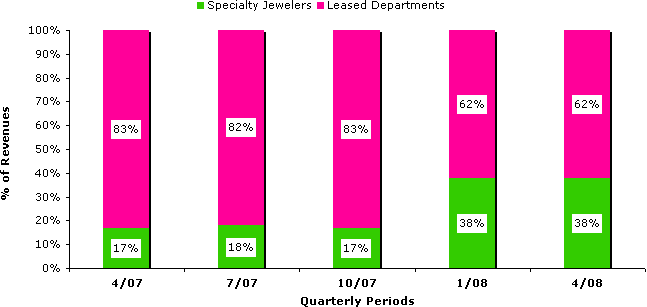IDEX Online Research: Finlay’s Q1 Disappointing, But Outlook Promising
June 08, 08
If you still think of Finlay as an operator of leased departments, it is time to change your view. In the first fiscal quarter ended April 2008, nearly 40 percent of its sales came from its specialty jewelry stores – Carlyle, Congress, and Bailey Banks & Biddle.
Further, despite severe disruptions in its traditional distribution channel – leased departments in U.S. department stores – and despite an uncooperative retail environment, Finlay’s sales should reach $1 billion this year, in line with prior record-setting periods.
Finally, despite weak sales which provided no leverage for the company’s relatively fixed overhead costs, Finlay’s operating cost ratio fell significantly as a percentage of sales in the first fiscal quarter ended April 2008.
While Finlay is arguably in transition, the long term signs seem reasonably positive, despite Wall Street’s chill toward the company and the current operating losses which are piling up.
Finlay: In Transition
Finlay Enterprises’ management has been seeking alternative opportunities beyond its core leased department business for many years. In 1994, it entered the international retailing market by acquiring Société Nouvelle d’ Achat de Bijouterie (“Snoab), the largest operator of leased departments in France, with 144 doors in five host store groups, including Galeries Lafayette, Nouvelles Galeries, and Bazar de L’Hotel de Ville. In January, 2000, Finlay exited that business due to weak sales and lack of profits.
In 2000, the company pioneered a partnership with 1-800-Flowers in an effort to tap the online market, which was still in its infancy at the time. That effort floundered.
Some would say that Finlay’s chairman Art Reiner was simply trying to grow the company, particularly in response to Wall Street’s insistent quest for rising sales and profits. Others, including this researcher, believe that Reiner saw the handwriting on the wall: the concept of leased departments was fading from the U.S. retail landscape.
Despite its early efforts which ended unsuccessfully, Reiner finally tapped into a market that has great promise: guild jewelry sales. With the acquisition of Carlyle in May 2005, followed by the acquisition of Congress in November 2006, and most recently the acquisition of Bailey Banks and Biddle in November 2007, Finlay has a solid footprint in the guild jewelry business. Finlay has avoided the bloodbath that is taking place among independent specialty jewelers who focus solely on the mass market; instead, the guild segment of the market is generally more stable and more profitable than some other segments.
The following graph illustrates the increased importance of Finlay’s specialty store division versus the revenue contribution from its leased departments.
| Finlay - Revenue Mix by Quarter |
First Quarter Highlights
Despite rising sales, Finlay’s operating loss widened in the first fiscal quarter ended April 2008, as the table below illustrates.

- Total sales +26 percent; same-store sales down 4.5 percent – Total revenues at Finlay rose by 25.9 percent in the quarter, based on continuing operations; same-store sales were down 4.5 percent. In its leased departments, demand for fashion diamond jewelry was weak while demand for better watches and designer jewelry was strong. In Bailey Banks & Biddle, diamond solitaire and bridal demand started weak, but picked up as the quarter progressed.
- Gross margin 44.9 percent vs 46.9 percent – Finlay’s gross margin fell by 200 basis point due to three key factors: 1) a much higher sales mix from its specialty stores which generate an inherently lower gross margin; 2) its LIFO provision of $2 million in the quarter versus $900,000 last year (this accounted for about half of the gross margin slippage); and, 3) volume discounts from vendors which were lower this year (that factor represented about one-quarter of the gross margin slippage).
- Operating cost ratio 46.8 percent vs 47.8 percent – Two factors helped push down Finlay’s operating cost ratio: 1) operating efficiencies, especially at Bailey Banks & Biddle; and, 2) the inherently lower operating cost structure in its specialty jewelry division.
Management continues to forecast sales in the $1 billion range for its fiscal year ended January 2009, with same-store sales flat to up 1 percent for the full fiscal year. The company’s net loss for the current year is expected to exceed last year’s loss by a moderate amount.
In the Bailey Banks & Biddle (BBB) division, management said it will focus on selling fashion jewelry, diamonds, and fine watches. Its marketing efforts will be directed to the best markets with the highest concentration of BBB stores in an effort to most efficiently use the company’s marketing budget. Finlay has found that BBB’s customers often buy jewelry for life’s milestone occasions – births, birthdays, engagements, weddings, and anniversaries. In contrast, customers who shop at Finlay’s leased departments are generally looking for fashionable jewelry for self-purchase.
